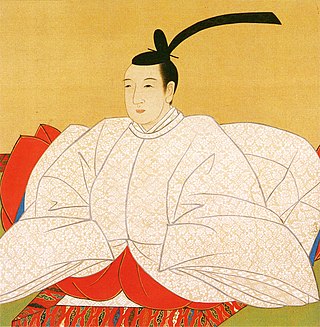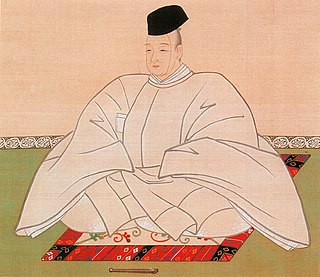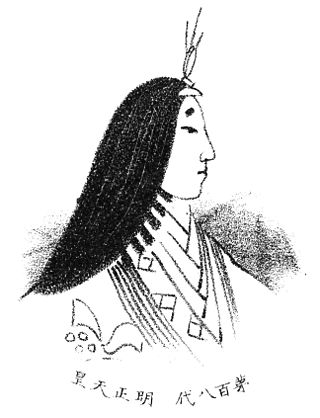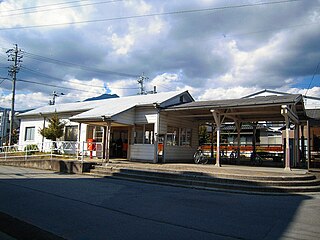| |||||
| Decades: | |||||
|---|---|---|---|---|---|
| See also: | Other events of 1740 History of Japan • Timeline • Years | ||||
Events in the year 1740 in Japan .
| |||||
| Decades: | |||||
|---|---|---|---|---|---|
| See also: | Other events of 1740 History of Japan • Timeline • Years | ||||
Events in the year 1740 in Japan .

Ayahito, posthumously honored as Emperor Ninkō, was the 120th emperor of Japan, according to the traditional order of succession. Ninkō's reign spanned the years from 1817 until his death in 1846, and saw further deterioration of the power of the ruling Shōgun. Disasters, which included famine, combined with corruption and increasing Western interference, helped to erode public trust in the bakufu government. Emperor Ninkō revived certain court rituals and practices upon the wishes of his father. However, it is unknown what role, if any, the Emperor had in the turmoil which occurred during his reign.

Morohito, posthumously honored as Emperor Kōkaku, was the 119th emperor of Japan, according to the traditional order of succession. Kōkaku reigned from 1779 until his abdication in 1817 in favor of his son, Emperor Ninkō. After his abdication, he ruled as Daijō Tennō also known as a Jōkō (上皇) until his death in 1840. The next emperor to abdicate was Akihito, 202 years later.

Hidehito, posthumously honored as Emperor Go-Momozono, was the 118th emperor of Japan, according to the traditional order of succession. He was named after his father Emperor Momozono. The wording of go- (後) in the name translates as "later", so he has also been referred to as "Later Emperor Momozono", "Momozono, the second", or "Momozono II".

Tōhito, posthumously honored as Emperor Momozono, was the 116th emperor of Japan, according to the traditional order of succession. Momozono's reign spanned the years from 1747 until his death in 1762. Momozono's reign was mostly quiet, with only one incident occurring that involved a small number of Kuge who advocated for the restoration of direct Imperial rule. These Kuge were punished by the shōgun, who held de facto power in the country.

Teruhito, posthumously honored as Emperor Sakuramachi was the 115th emperor of Japan, according to the traditional order of succession. He was enthroned as Emperor in 1735, a reign that would last until 1747 with his abdication. As with previous Emperors during the Edo period, the Tokugawa shogunate had control over Japan.

Okiko, posthumously honored as Empress Meishō, was the 109th monarch of Japan, according to the traditional order of succession. Her reign lasted from 1629 to 1643.

Meiwa (明和) was a Japanese era name after Hōreki and before An'ei. This period spanned the years from June 1764 through November 1772. The reigning empress and emperor were Go-Sakuramachi-tennō (後桜町天皇) and Go-Momozono-tennō (後桃園天皇).

Hōreki (宝暦), also known as Horyaku, was a Japanese era name after Kan'en and before Meiwa. The period spanned the years from October 1751 through June 1764. The reigning emperor and empress were Momozono-tennō (桃園天皇) and Go-Sakuramachi-tennō (後桜町天皇).

Enkyō (延享) was a Japanese era name after Kanpō and before Kan'en. This period spanned the years from February 1744 through July 1748. The reigning emperors were Sakuramachi-tennō (桜町天皇) and Momozono-tennō (桃園天皇).

Genbun (元文) was a Japanese era name after Kyōhō and before Kanpō. This period spanned the years from April 1736 through February 1741. The reigning emperor was Sakuramachi-tennō (桜町天皇).

Yōga is a neighborhood in Setagaya, Tokyo. Its name appears frequently in traffic reports because the junction between the Tōmei Expressway and the elevated Shibuya branch (#3) of the Metropolitan Expressway system is there. There is also a stop, Yōga Station, on the Tōkyū Den-en-toshi line here. There is also a bus services and possible access to the area with numbers of buses.

The Nagasaki Electric Tramway is a private tram system in Nagasaki, Japan. Since March 20, 2008, its lines accept Nagasaki Smart Card, a smart card ticketing system.

Nijō Yoshitada, son of regent Nijō Tsunahira, was a Japanese kugyō of the Edo period. He held a regent position kampaku from 1736 to 1737. He married a daughter of the fourth head of Kaga Domain Maeda Tsunanori. Nijō Munehira was his son. Also, one of his daughters was a consort of Emperor Sakuramachi.
Princess Yoshiko was the empress consort of Emperor Kōkaku of Japan. She enjoys the distinction of being the last daughter of an emperor who would herself rise to the position of empress. When she was later given the title of Empress Dowager, she became the first person to be honored with that title while still living since 1168.

Sakuramachi-mae Station is a railway station in the city of Nishio, Aichi, Japan, operated by Meitetsu.

Sakuramachi Station is a railway station on the Iida Line in the city of Iida, Nagano Prefecture, Japan, operated by Central Japan Railway Company.
Tsuki no wa no misasagi (月輪陵) is the name of a mausoleum in Higashiyama-ku, Kyoto used by successive generations of the Japanese Imperial Family. The tomb is situated in Sennyū-ji, a Buddhist temple founded in the early Heian period, which was the hereditary temple or bodaiji (菩提寺) of the Imperial Family.

Toshiko, posthumously honored as Empress Go-Sakuramachi was the 117th monarch of Japan, according to the traditional order of succession. She was named after her father Emperor Sakuramachi, with the word go (後) before her name translating in this context as "later" or "second one". Her reign spanned the years from 1762 through to her abdication in 1771. The only significant event during her reign was an unsuccessful outside plot that intended to displace the shogunate with restored imperial powers. As of 2024, she remains the most recent empress regnant of Japan as the current constitution does not allow women to inherit the throne.
Events in the year 1813 in Japan.
Events from the year 1737 in Japan.